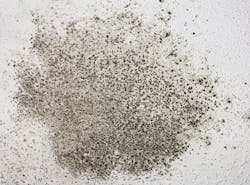Mold and Liability
Personal injury litigation over mold exposure won’t disappear from court dockets anytime soon, facilities managers and attorneys alike will attest. Facilities are landing in the defendant’s chair for a steadily increasing number of mold claims, with the plaintiffs demanding huge payouts in monetary damages.
A notable 2016 case awarded $1.8 million to a music teacher who developed adult onset asthma and other lung issues in response to what she described as dripping water in her classroom that led to mold growth, stains and seepage through the walls.
One particularly heartbreaking case in 2017 involved a patient who died from a toxic mold infection while undergoing treatment for acute myeloid leukemia at University of Pittsburgh Medical Center Shadyside. Her family alleged that she contracted the infection at the hospital, a conclusion they drew after an internal report found mold at the laundry facility that handled linens for all of the center’s 22 facilities.
What Are the Risks?
The level of liability that a commercial facilities manager or building owner has in terms of mold is something that a court would determine if a third-party suit were brought against the building owner or management, says consultant Mary Jane O’Keefe, principal of MJ Associates, a San Diego risk management consulting firm specializing in commercial real estate-related exposures and issues.
[Related: The Terrifying Resurfacing of Asbestos]
Insurance policies do help limit hefty litigation payouts, but it’s tough to find policies that don’t carry some sort of mold exclusion. Mold coverage has been carved out of most first-party property and third-party general liability policies, O’Keefe notes, though it can be purchased as part of pollution legal liability insurance.
Professional liability insurance for construction professionals may provide coverage for mold that’s a direct result of poor construction, but that won’t protect you if the mold stems from negligent management.
“Right now, there are problems with this policy that I hope the insurance industry will address,” O’Keefe notes. For example, pollution legal liability policies were originally designed to cover sites that the U.S. Environmental Protection Agency (EPA) or another governmental agency has demanded to be cleaned by the policyholder. For first-party coverage to apply, an agency has to write a letter to the owner and/or manager and demand that the property be cleaned up.
“This rarely happens in the case of mold,” O’Keefe says, “so usually there is no first-party property damage coverage available.”
Damage to a third party’s personal property and any bodily injury claims by a third party can also be covered by pollution legal liability insurance, O’Keefe says. Medical issues that may arise in an employee due to working in an environment that has mold would be covered under Workers’ Compensation.
As a rule, mold exclusions abound in the insurance world, so it may take some sleuthing to find a policy with good mold coverage.
The good news is that mold exclusions will not necessarily limit coverage. Even policies that expressly exclude coverage for “losses caused by mold” will not necessarily exclude all claims seeking recovery for mold damages, despite the inevitable insurance company claims to the contrary, John Berringer, a partner for Reed Smith LLP, says.
There have been court cases setting this precedent. Berringer offers this advice: shop around.
“Get as narrow of an exclusion from mold as you can,” Berringer says. “If you can get a policy without a mold exclusion, that’s great.”
There’s some good news when it comes to older claims. Old policies may still carry some sort of mold coverage. This can be beneficial in litigation because if mold can be traced back to a fire loss or a broken water pipe that happened years ago, for example, the policy in effect at that time is the one the court will examine – not the building’s current policy, particularly if an expert can attest that the mold infestation began years ago when that policy was in effect, Berringer says. And chances are, older policies will have a less broad mold exclusion than those written today.
[Read also: 3 Tips for Better Facility Hygiene]
“Maintain copies of every year’s policy forever, and I really mean forever,” Berringer says. “There’s always some triggering event for mold growth. If you can find that event, and if it is far enough back before there was an exclusion, you can claim coverage.”
Mold Prevention Tips
Staying on top of mold is the key to preventing these lawsuits. The EPA offers this advice for protecting your occupants (and your reputation):
Reduce humidity.
Vent showers and anything else that generates moisture to the outside. Monitor the humidity levels inside your building and deploy air conditioning and dehumidification wherever you need it. Stay on top of maintenance for exhaust fans in kitchen areas.
Prevent condensation.
Add insulation to stop condensation from forming on cold surfaces.
Inspect regularly.
Make sure people know how to report moldy odors or visual signs of mold. Look for water stains and discoloration on ceilings, walls, floors and windows sills.
Bathrooms and kitchen sinks are at a high risk for mold, so inspect them regularly for mold growth and standing water. Fix leaking pipes and appliances immediately. If building materials or furnishings get wet, be sure to clean and completely dry them within 24-48 hours to stop mold from growing. Ensure flooring dries completely whenever you clean it with water.
Take immediate action if you see mold.
Clean any hard surfaces that have mold spots with water and detergent following the detergent manufacturer’s instructions, then thoroughly dry the area. You may not be able to salvage soft surfaces that are moldy, like ceiling tiles.
Robin Suttell, based in Cleveland, is a contributor for BUILDINGS magazine. This article was originally posted in September 2003 and updated in October 2018. Janelle Penny contributed to this report.
Two handpicked articles to read next:

